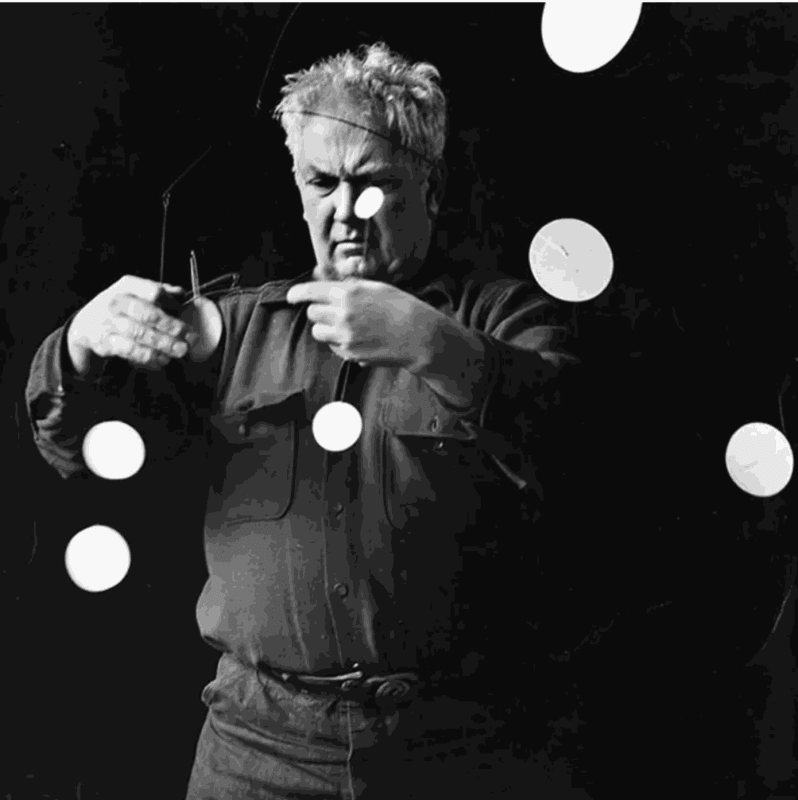
- X
- Tumblr
Alexander Calder (1898–1976) was an American sculptor renowned for his pioneering work in kinetic art and the creation of the mobile, a type of abstract sculpture that moves. Calder’s innovative approach revolutionized sculpture in the 20th century and left a lasting impact on the art world.
Alexander Calder was born on July 22, 1898, in Lawnton, Pennsylvania, USA, into a family of artists. His father, Alexander Stirling Calder, was a renowned sculptor, and his mother, Nancy Brady Calder, was a painter. Growing up in an artistic environment, Calder was exposed to art from a young age.
He initially studied mechanical engineering at Stevens Institute of Technology in Hoboken, New Jersey, from 1915 to 1919. Calder's background in engineering greatly influenced his later work, especially his understanding of movement and mechanics.
After completing his engineering studies, Calder pursued art at the Art Students League of New York. In 1923, he traveled to Paris, where he was introduced to the vibrant art scene of the 1920s. In Paris, Calder was influenced by various avant-garde movements, including Surrealism and Constructivism, and began experimenting with abstract forms and kinetic art.
In 1931, Calder invented the mobile, a type of abstract sculpture that moves in response to air currents. His mobiles were groundbreaking in their use of movement as an integral element of the artwork, rather than merely a passive feature.
Calder's career was marked by numerous significant works and exhibitions. Some of his notable creations include:
"Calder’s Circus" (1926) - An early work combining Calder's interest in engineering and performance art, featuring a miniature circus that he performed with.
"Two Black Divisions" (1937) - An abstract mobile that reflects Calder’s exploration of form and movement.
Calder’s work was featured in numerous important exhibitions worldwide, including:
The Museum of Modern Art, New York (1932) - Calder’s first major solo exhibition, showcasing his mobiles and static sculptures.
The Guggenheim Museum, New York (1952) - A significant retrospective that highlighted Calder’s contributions to modern art.
The Tate Gallery, London (1974) - An exhibition celebrating Calder’s impact on the international art scene.
Calder's personal life was closely intertwined with his art. In 1931, he married Louisa James, the granddaughter of the novelist Henry James. The couple had two children, Sandra and Alexander. Calder’s family life and travels often influenced his work and provided inspiration for his sculptures.
His artistic influences included the works of Jean Arp, Marcel Duchamp, and other avant-garde artists of the time. Calder’s engineering background also played a crucial role in his innovative approach to kinetic sculpture.
Alexander Calder continued to create and exhibit his work throughout his life, expanding his exploration of sculpture to include large public installations and monumental works. He was honored with numerous awards and retrospectives, including the National Medal of Arts in 1975.
Calder passed away on November 11, 1976, in New York City. His legacy endures through his transformative contributions to sculpture and modern art. Calder’s mobiles, stabiles, and large-scale installations remain influential and are featured in major museums and public spaces around the world.
Alexander Calder was a trailblazer in the world of modern art, renowned for his innovative use of movement and abstract form. His pioneering work with mobiles and his contributions to kinetic sculpture have left a lasting impact on the art world, ensuring his place as a central figure in 20th-century art history.